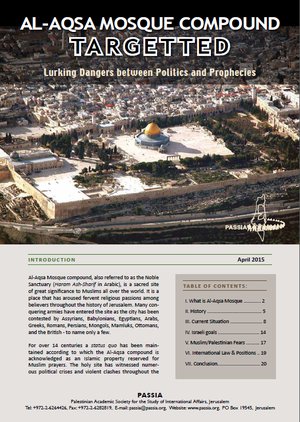Al-Aqsa Mosque Compound Targetted
Overview
Al-Aqsa Mosque compound, also referred to as the Noble Sanctuary (Haram Ash-Sharif in Arabic), is a sacred site of great significance to Muslims all over the world. It is a place that has aroused fervent religious passions among believers throughout the history of Jerusalem. Many conquering armies have entered the site as the city has been contested by Assyrians, Babylonians, Egyptians, Arabs, Greeks, Romans, Persians, Mongols, Mamluks, Ottomans, and the British - to name only a few. For over 14 centuries a status quo has been maintained according to which the Al-Aqsa compound is acknowledged as an Islamic property reserved for Muslim prayers. The holy site has witnessed numerous political crises and violent clashes throughout the years.
1The mosque’s sanctity and safety have been increasingly undermined since the Israeli occupation in 1967. In 1969, an Australian Christian Zionist, Dennis Rohan, even set Al-Aqsa (Al-Qibli) Mosque on fire, completely destroying large parts of it, including its Ayoubi-era pulpit.2 Historically the entire holy compound is a Muslim Waqf and Jewish law prohibits Jews from entering it, but “visits” by Jewish extremists under armed Israeli guard (while Palestinians are denied access) have escalated over the last decade and undeniably added a religious dimension to a predominantly political conflict. In recent years, particularly since 2014, the status quo at the Al-Aqsa compound appears to be eroding under attempts by the Israeli establishment and Jewish forces determined to strengthen their hold over the holy compound at the expense of Muslim rights. The Al-Aqsa sanctuary is undoubtedly one of the most sensitive and contentious locations on earth and a sticking point in the Israeli-Palestinian negotiations. Many are confused about what exactly constitutes AlAqsa, what is happening at the compound, and why now. This bulletin addresses these issues and provides a historical background and an overview of the latest developments. It explains the site’s significance for Muslims; the rising influence of the Jewish “Temple movements”, their attempts to force a change to the status quo; and the Palestinian narrative of the latest events amid fears of the danger faced by the Al-Aqsa sanctuary.
While this bulletin focuses on the recent events at Al-Aqsa Mosque compound, Palestinians, specifically in East Jerusalem, face numerous sources of frustration that have led to escalating violence and tensions; this cannot be understood in isolation from the larger picture of the Israeli-Palestinian conflict and the decadeslong occupation.

